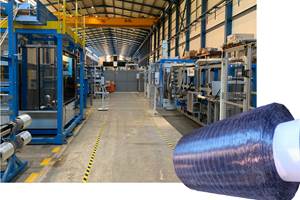All-recycled, needle-punched nonwoven CFRP slashes carbon footprint of Formula 2 seat
Dallara and Tenowo collaborate to produce a race-ready Formula 2 seat using recycled carbon fiber, reducing CO2 emissions by 97.5% compared to virgin materials.
Share
Dallara’s Formula 2 (F2) seat made from 100% recycled needle-punched nonwoven carbon fiber. Source | Dallara
Formula Two (F2) is the Fédération Internationale de l’Automobile’s (FIA) second-tier single-seater global racing championship — just under Formula One (F1), the top-tier. F2 serves as the final stage of the FIA Global Pathway from Karting to F1. It's a spec series, meaning drivers compete in identical machinery to showcase true talent. The Italian race car manufacturer Dallara Group S.r.l. (Varano de’ Melegari, Italy) supplies the sole chassis for the entire F2 grid — a carbon fiber-reinforced polymer (CFRP)/aluminum honeycomb sandwich structure monocoque called the F2 2024.
The FIA has recently been on a mission to implement more environmentally conscious regulations throughout the racing series it sanctions, such as reducing the usage of exotic materials in car components and powertrains and introducing measures like ethanol blends in the fuel to align with environmental goals while maintaining high performance standards. Leveraging its extensive research efforts to improve its motorsport and automotive offerings, in 2024 Dallara expanded its focus on enhancing the environmental sustainability of F2 cars collaborating with recycled nonwoven composite specialist Tenowo (Hof, Germany) to develop an F2 safety seat that meets FIA requirements while significantly reducing environmental impact.
The seat, engineered by Dallara, is constructed using 100% recycled, needle-punched nonwoven CFRP and achieves a 97.5% reduction in CO2 emissions compared to seats made with virgin carbon fiber. This drops seat production from 40 kilograms of CO2 equivalent per kilogram of material to just 1 kilogram.
Seat specifications and regulations
The FIA’s specifications for extractable seats in open cockpit car regulations outline stringent requirements for F2 seat design. Key specifications include shape, head stabilization attachment fixations, straps and buckles and extraction time. The seat must extend from the driver’s coccyx
A vertical or near-vertical slot in the highest part of the seat back must accommodate a head stabilization device, with specific dimensions to fit the FIA standard. The seat must also pass an extraction test where it can be removed from the car with the driver strapped in without adjusting the harness, initially pulled in the direction of the car’s vertical axis within a given time. These regulations guided Dallara’s design process, ensuring the recycled CFRP seat met all safety and performance criteria.
Needle-punched nonwoven rCF
Tenowo’s needle-punched nonwoven recycled carbon fiber (rCF) is the F2 seat’s key innovation. The manufacturing process involves using secondary carbon fiber from various sources such as edge cuts, loops and trimmings from woven and noncrimp fabric (NCF) production, leftover rovings, textile cutoffs, and fibers from end-of-life components.
Recycled edge cuts, loops and trimmings from woven and noncrimp fabric (NCF) production are used to feed the nonwoven material production. Source | Tenowo
The process begins by preparing the rCF, which is mechanically or thermally adjusted to a length of 40-80 millimeters and then carded to form a loose web. This initial alignment of the fibers plays a crucial role in determining the directional properties of the final material. Subsequently, the web undergoes a fiber pile laying process, where multiple layers are cross laid to achieve the desired thickness and further control the orientation of the fibers.
The next crucial step is the needle-punch process, which entails mechanical bonding or fixation of the nonwoven materials. Barbed needles are used to repeatedly punch through the layered fiber web. As the needles penetrate, they carry fibers from the top layers down through the material's thickness, creating a complex 3D fiber entanglement. This action significantly enhances the material’s structural integrity and mechanical properties.
The needle punching equipment comprises a needle board with thousands of barbed needles, a stripper plate and a bed plate. The web passes between the stripper plate and bed plate, while the needle board moves up and down, driving the needles through the web. The frequency of needle punches, the depth of needle penetration and the advance rate of the web can all be adjusted to control the final material properties.
The needle-punching process highlights how a significant proportion of fibers are oriented in the Z-direction. Source | Tenowo
The Dallara and Tenowo F2 seat production uses a needle-punched nonwoven with a fiber distribution of 40% in the warp direction and 60% in the weft direction. This specific orientation contributes to the material’s quasi-isotropic behavior, providing balanced properties in multiple axes.
The process is also responsible for creating a significant proportion of fibers oriented in the Z-direction, which contributes to the material’s voluminous nature and enhances its performance in multiple ways. This 3D fiber alignment improves the material’s ability to absorb energy during impacts, enhances its acoustic and vibrational damping properties and enables effective thickness buildup with minimal layers.
Additionally, the unique structure created by the needle-punch process enhances resin penetration during subsequent manufacturing stages. This characteristic not only improves the material’s mechanical properties but also contributes to more efficient and consistent production processes. For example, the material’s enhanced drapability compared to textiles facilitates easy forming of the complex shapes required in the seat’s design.
This needle-punched nonwoven can be produced with a width of up to 2,000 millimeters and a grammage ranging from 100-600 gsm, providing flexibility in design and manufacturing. Recycled nonwoven CFRP typically uses a lower fiber volume fraction (25-35%) when consolidated compared to a woven variant (60%+), resulting in a higher resin content and lower overall density.
Michael Bernegg, head of business development at Tenowo, highlights the sustainability and processing advantages of nonwoven CFRP: “The production of needle-punched nonwoven CFRP requires significantly less energy compared to virgin carbon fiber production, making it an environmentally friendly choice. Additionally, the use of rCF contributes to waste diversion and the enhanced material impregnation properties during molding lead to reduced production cycle times and therefore energy consumption.”
F2 seat design, manufacturing optimization
Dallara’s F2 seat is produced in collaboration with Faber Composites (Casina, Italy) using a resin transfer molding (RTM) process, which was found to be well suited to the characteristics of the nonwoven material. Manufacturing begins with cutting and layup, where the dry Tenowo needle-punched nonwoven is cut to shape and laid up in the mold, a procedure that takes approximately 30 minutes.
Giuseppe Salemi, head of research at Dallara, explains the layup approach: “We strategically adjusted the fiber orientation of each layer to spread local stress over a larger area, improving overall performance. Additionally, we incorporated localized reinforcements in specific areas of the part.”
After layup, the mold is sealed and epoxy resin is injected, saturating the nonwoven reinforcement, a step that also takes about 30 minutes. The part then cures as a result of the epoxy’s exothermic reaction, reaching a maximum of 70°C. After a 4-hour cure, the seat is removed from the mold for trimming and finishing.
Micaela Sebastiani, a process engineer at Dallara, emphasizes the value of the wet-out properties of the nonwoven material in the RTM process. “This facilitated efficient resin penetration and minimized void content,” she notes. “Initially, prototypes were developed before achieving the desired consolidation of the fabric and material with minimal waste.”
“Finally, we were able to achieve a zero-scrap production process, which further enhances the sustainability credentials of the seat,” she continues. “The manufacturing process we developed is stable and consistent, with a production capacity of one seat per day.”
Testing the seat
In order to meet the FIA requirements for F2 seats, a thorough testing process was necessary. Dallara created its own testing protocol to guarantee the seat’s structural integrity and safety. This involved pre-production FEA simulations to analyze material mechanics and extensive simulations and physical tests to optimize the strength-to-weight ratio. Additionally, post-production mechanical testing and environmental testing were conducted to verify the seat’s performance.
“The focus was on ensuring that the seat could withstand crash forces while still allowing for safe and fast driver extraction,” notes Salemi. “Thermal management was also a key consideration, with post-cure treatments conducted on the components to ensure reliable performance under race conditions. The recycled CFRP seat successfully met all FIA requirements.”
Sustainability impact, future applications
The implementation of Tenowo’s 100% recycled, needle-punched nonwoven carbon fiber has led to a significant reduction in the carbon footprint of the seat. Notably, the success of this project has resulted in wider applications within motorsport — Dallara has already integrated this material into the front wing element of F2 and F3 cars.
Dallara has also indicated plans to expand the use of this material and technology across various sections of race cars, with the ultimate goal of integrating it into the automotive industry. This sentiment is shared by Tenowo, who sees potential beyond motorsport, indicating that initial observations suggest promising performance for lightweight and heat shielding applications in road vehicles. However, they note that this technology is still in its early stages, and further research and development are required to fully realize its potential.
The development of this rCF F2 seat demonstrates that high performance and sustainability can be combined in motorsport applications. As the automotive and motorsport industries continue to seek more sustainable solutions, innovations like this seat may pave the way for a new generation of high-performance, low environmental impact composite components.
Related Content
Natural fiber composites: Growing to fit sustainability needs
Led by global and industry-wide sustainability goals, commercial interest in flax and hemp fiber-reinforced composites grows into higher-performance, higher-volume applications.
Read MoreTU Munich develops cuboidal conformable tanks using carbon fiber composites for increased hydrogen storage
Flat tank enabling standard platform for BEV and FCEV uses thermoplastic and thermoset composites, overwrapped skeleton design in pursuit of 25% more H2 storage.
Read MoreSulapac introduces Sulapac Flow 1.7 to replace PLA, ABS and PP in FDM, FGF
Available as filament and granules for extrusion, new wood composite matches properties yet is compostable, eliminates microplastics and reduces carbon footprint.
Read MoreNovel dry tape for liquid molded composites
MTorres seeks to enable next-gen aircraft and open new markets for composites with low-cost, high-permeability tapes and versatile, high-speed production lines.
Read MoreRead Next
Filament winding increases access to high-performance composite prostheses
Steptics industrializes production of CFRP prostheses, enabling hundreds of parts/day and 50% lower cost.
Read MoreComposite accelerator pedal enhances Formula SAE performance
Venox Systems was brought into the fold to deliver a 3D printed continuous carbon fiber/PEKK pedal for the TU Wien Racing Team that exceeded its aluminum counterpart.
Read MoreThe untapped potential in Formula 1 composite manufacture
Formula 1’s midfield teams are struggling to bridge the gap to their better resourced frontrunning counterparts. Could Industry 4.0 composites manufacturing automation level the playing field?
Read More










.png;maxWidth=300;quality=90)








